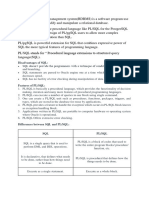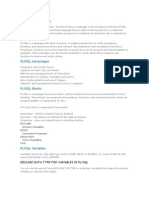0 ratings0% found this document useful (0 votes)
2 viewsConditional Control Structures
The document explains control structures in PL/SQL, which alter the logical flow of statements. It details four basic types: conditional control, iterative control, sequential control, and unconditional branching, focusing on conditional control statements such as IF-THEN, IF-THEN-ELSE, and IF-THEN-ELSEIF. Each type of conditional statement has specific syntax and examples demonstrating their use in executing statements based on certain conditions.
Uploaded by
lokibeaverCopyright
© © All Rights Reserved
We take content rights seriously. If you suspect this is your content, claim it here.
Available Formats
Download as PPT, PDF, TXT or read online on Scribd
0 ratings0% found this document useful (0 votes)
2 viewsConditional Control Structures
The document explains control structures in PL/SQL, which alter the logical flow of statements. It details four basic types: conditional control, iterative control, sequential control, and unconditional branching, focusing on conditional control statements such as IF-THEN, IF-THEN-ELSE, and IF-THEN-ELSEIF. Each type of conditional statement has specific syntax and examples demonstrating their use in executing statements based on certain conditions.
Uploaded by
lokibeaverCopyright
© © All Rights Reserved
We take content rights seriously. If you suspect this is your content, claim it here.
Available Formats
Download as PPT, PDF, TXT or read online on Scribd
You are on page 1/ 4
CONTROL STRUCTURES
Control structure enables the program to change the logical flow of statements
within PPL/SQL.
PL/SQL supports 4 basic programming control structure :-
i) Conditional control
ii) Iterative control
iii) Sequential control
iv) Unconditional Branching
i)CONDITIONAL CONTROL STATEMENTS :-
We can execute a statement sequence or sequence of statements conditionally with
IF-THEN-ELSE Statement .
There are 3 Conditional control statements. They are.,
i) IF-THEN Statements
ii) IF-THEN-ELSE Statements
ii) IF-THEN-ELSEIF Statements
i)IF-THEN Statements :-
It is the simple form.
Syntax :-
IF condition THEN
Statement (s);
END IF ;
The statements that immediately follow the conditional IF statement are
Executed only if the condition evaluation is TRUE. If the condition evaluates to
FALSE, the statements are not processed and are passed over.
Example ,
IF grade = ‘A’ THEN
UPDATE employee_table SET tax = salary * 0.4;
END IF;
ii)IF-THEN-ELSE Statements :-
Syntax :-
IF condition THEN
Statement (s);
ELSE
Statement (s);
END IF ;
The statements that immediately follow the conditional IF statement are
Executed only if the condition evaluation is TRUE. If the condition evaluates to
FALSE, the immediately following the ELSE portion are executed .
Example ,
IF grade = ‘A’ THEN
UPDATE employee_table SET tax = salary * 0.4;
ELSE
UPDATE employee_table SET tax = salary * 0.3;
END IF;
Each IF THEN statement can have only one ELSE statement and must
end with an END IF statement.
iii)IF-THEN-ELSEIF Statements :-
In some structure, we need to select an action from several mutually exclusive alternatives. The IF-
THEN-ELSEIF statements give the solution for this.
Syntax :-
IF condition1 THEN
Statement (s);
ELSEIF condition2 THEN
Statement (s);
ELSE
Statement (s);
END IF ;
Example ,
IF num1>num2 THEN
dbms_output.put_line(‘Num1 is greater than num2’);
ELSEIF num1 = num2 THEN
dbms_output.put_line(‘both numbers are equal’);
ELSE
dbms_output.put_line(‘num2 is greater than num1’);
END IF;
You might also like
- Visual Studio Performance Testing Quick Reference Guide 3 - 6No ratings yetVisual Studio Performance Testing Quick Reference Guide 3 - 6253 pages
- Reading With Ingold. An Analysis of Tim PDFNo ratings yetReading With Ingold. An Analysis of Tim PDF94 pages
- PL/SQL - Conditions: IF - THEN StatementNo ratings yetPL/SQL - Conditions: IF - THEN Statement22 pages
- Ppt of Chapter 2.3 - Control StructuresNo ratings yetPpt of Chapter 2.3 - Control Structures37 pages
- II&CT Lecture 21 - 22 Programming Fundamentals in C++ (Conditinal Statements)No ratings yetII&CT Lecture 21 - 22 Programming Fundamentals in C++ (Conditinal Statements)37 pages
- CH-4 PL-SQL Database Objects & SecurityNo ratings yetCH-4 PL-SQL Database Objects & Security32 pages
- Muhammad Ali Nayeem Student of KnowledgeNo ratings yetMuhammad Ali Nayeem Student of Knowledge18 pages
- Control Structures: Conditional Control Iterative Control Sequential Control100% (1)Control Structures: Conditional Control Iterative Control Sequential Control50 pages
- PL/SQL Introduction: Declare Data Type For Variables in PL/SQLNo ratings yetPL/SQL Introduction: Declare Data Type For Variables in PL/SQL15 pages
- What Is PL/SQL?: PL/SQL Stands For Procedural Language Extension of SQLNo ratings yetWhat Is PL/SQL?: PL/SQL Stands For Procedural Language Extension of SQL25 pages
- 2. Control Structure- Conditinal ControlNo ratings yet2. Control Structure- Conditinal Control1 page
- BE EXPERT IN JAVA Part- 2: Learn Java programming and become expertFrom EverandBE EXPERT IN JAVA Part- 2: Learn Java programming and become expertNo ratings yet
- Pharo: An Immersive Object-Oriented System: Damien CASSOU, Stéphane DUCASSE and Luc FABRESSENo ratings yetPharo: An Immersive Object-Oriented System: Damien CASSOU, Stéphane DUCASSE and Luc FABRESSE25 pages
- Career Astrology: Which Career Is Best For Me According To My Birth Chart and d10 Chart?100% (2)Career Astrology: Which Career Is Best For Me According To My Birth Chart and d10 Chart?5 pages
- Client Acceptance, Main Concept Audit and Planning AuditNo ratings yetClient Acceptance, Main Concept Audit and Planning Audit25 pages
- Seismic Design of Concrete Bridges: Some Key Issues To Be Addressed During The Evolution of Eurocode 8 - Part 2No ratings yetSeismic Design of Concrete Bridges: Some Key Issues To Be Addressed During The Evolution of Eurocode 8 - Part 23 pages
- Taking Risks and Making Profits Within The Dynamic Business EnvironmentNo ratings yetTaking Risks and Making Profits Within The Dynamic Business Environment55 pages
- Dh.022.Sep.2024 Hasil Seleksi Tahap 1 Staff Development ProgramNo ratings yetDh.022.Sep.2024 Hasil Seleksi Tahap 1 Staff Development Program13 pages
- All_India_Final_Year_Graduation_Arts_2023_24_Batch_SAMPLE_2No ratings yetAll_India_Final_Year_Graduation_Arts_2023_24_Batch_SAMPLE_221 pages
- Concise Introduction to Logic 13th Edition Hurley Test Bank instant download100% (4)Concise Introduction to Logic 13th Edition Hurley Test Bank instant download34 pages

























































































